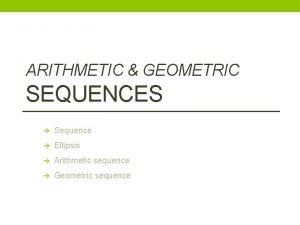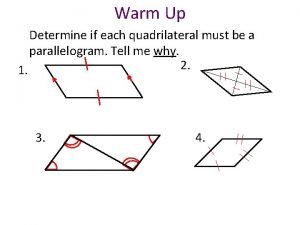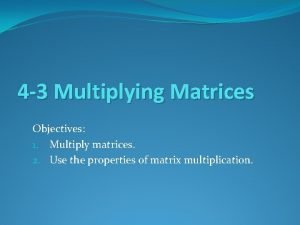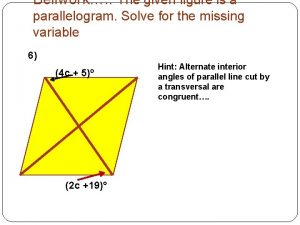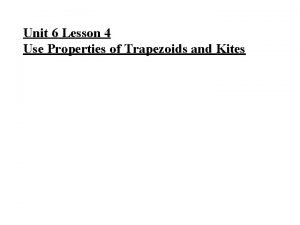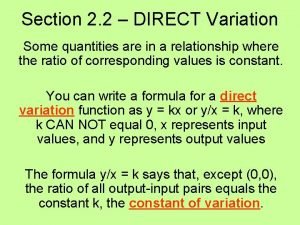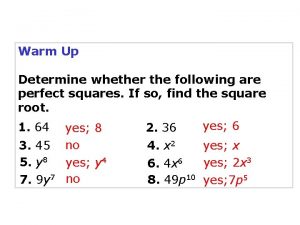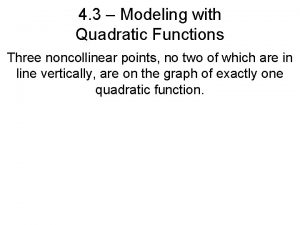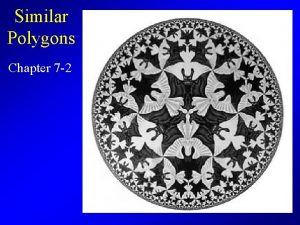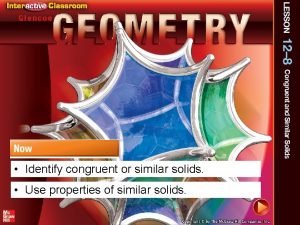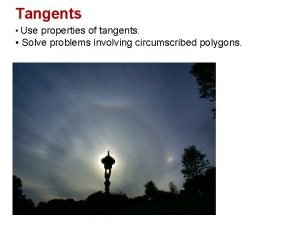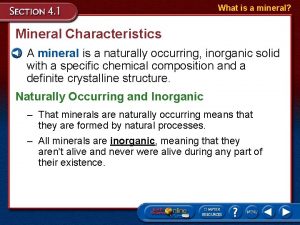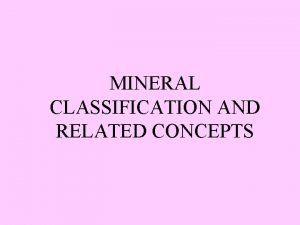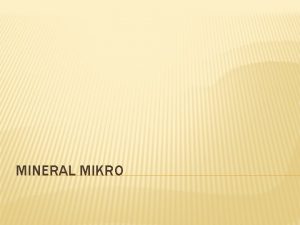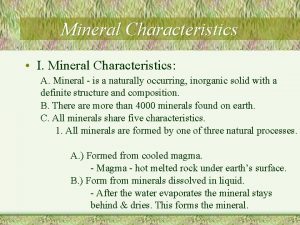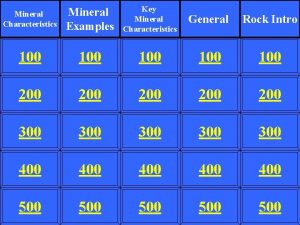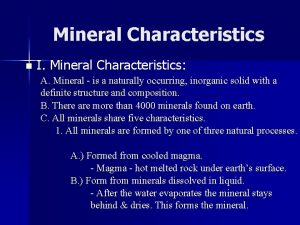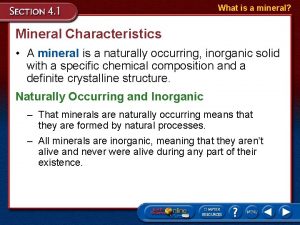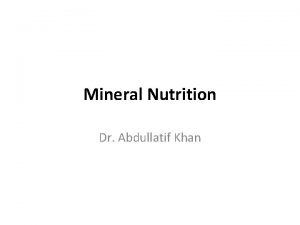Mineral dissolutionprecipitation To determine whether or not a













- Slides: 13

Mineral dissolution/precipitation • To determine whether or not a water is saturated with an aluminosilicate such as K-feldspar, we could write a dissolution reaction such as: • KAl. Si 3 O 8 + 4 H+ + 4 H 2 O K+ + Al 3+ + 3 H 4 Si. O 40 • We could then determine the equilibrium constant: • from Gibbs free energies of formation. The IAP could then be determined from a water analysis, and the saturation index calculated.

INCONGRUENT DISSOLUTION • Aluminosilicate minerals usually dissolve incongruently, e. g. , 2 KAl. Si 3 O 8 + 2 H+ + 9 H 2 O Al 2 Si 2 O 5(OH)4 + 2 K+ + 4 H 4 Si. O 40 • As a result of these factors, relations among solutions and aluminosilicate minerals are often depicted graphically on a type of mineral stability diagram called an activity diagram.

ACTIVITY DIAGRAMS: THE K 2 O-Al 2 O 3 -Si. O 2 -H 2 O SYSTEM We will now calculate an activity diagram for the following phases: gibbsite {Al(OH)3}, kaolinite {Al 2 Si 2 O 5(OH)4}, pyrophyllite {Al 2 Si 4 O 10(OH)2}, muscovite {KAl 3 Si 3 O 10(OH)2}, and K-feldspar {KAl. Si 3 O 8}. The axes will be a K+/a H+ vs. a H 4 Si. O 40. The diagram is divided up into fields where only one of the above phases is stable, separated by straight line boundaries.

Activity diagram showing the stability relationships among some minerals in the system K 2 O-Al 2 O 3 -Si. O 2 -H 2 O at 25°C. The dashed lines represent saturation with respect to quartz and amorphous silica.

Aluminum


Linking nutrient cycling and redox chemistry in fresh water lakes P cycling and sediment microbes PO 43 - Iron reducers Fe. OOH PO 43 - Fe 2+ H 2 S Sulfate Reducers Fe. S 2 PO 43 - PO 43 Blue Green Algae blooms? N cycling and sediment microbes NO 3 - Ammonifying bacteria NH 4+

Solid State Analysis • X-Ray Fluorescence Spectroscopy (XRF) • X-ray Diffraction (XRD)

Extractions • Using selected acids, bases, organics, chelators to dissolve a subset of minerals • Many possibilities for this • We will look at 2 used to investigate Fe, Mn, P: – Aqua Regia – Combination of Nitric Acid and Hydrochloric acid, heated to just below boiling – dissolved most stuff (but not all!!) – Ascorbic Acid extraction – Combination of ascorbic acid and bicarbonate

Fe. OOH/Mn. OOH in sediments • Ascorbic acid extraction technique specific to ‘reactive’ Fe and Mn (Kostka and Luther, 1994) • XRD data confirms reactive stuff is ferrihydrite • Size is nanloparticulate, sensitive to degree of recycling!

Where is the Phosphorus? P mobility measured through hundreds of sediment digests for samples in Missisquoi Bay collected at different times, places, and depths Only strong and consistent correlation is with reactive Fe, present predominantly as nanoparticulate Fe. OOH particles 2008 Sediment Extraction Correlation Statistics Ascorbic Acid (reactive) R 2 p-value n Aqua Regia (total) R 2 p-value n P vs. Fe 0. 8952 6. 4 x 10 -100 202 0. 1940 3. 5 x 10 -10 185 P vs. Mn 0. 6561 3. 1 x 10 -48 202 0. 3026 5. 0 x 10 -16 185 P vs. Ca 0. 6895 2. 7 x 10 -27 184 0. 1709 5. 0 x 10 -9 185 P vs. Al 0. 4653 1. 5 x 10 -26 184 0. 6883 3. 4 x 10 -48 185

2008 Reactive Fe vs P 2007 Reactive Fe & Mn vs Reactive P 0. 700 1. 2 Fe vs P 0. 500 P vs. Mn R 2 = 0. 8952 1 mg P/g dry sed. 0. 600 0. 400 0. 300 R 2 = 0. 8862 0. 200 0. 100 R 2 = 0. 5681 0. 000 1. 000 0. 8 0. 6 0. 4 0. 2 2. 000 3. 000 4. 000 5. 000 6. 000 7. 000 0 0 5 10 Fe mg/g dry sed. 15 20

2007 Total Fe vs Total P 2008 Total Fe and Mn vs P 2. 50 R 2 = 0. 6537 2. 00 R 2 = 0. 5946 mg P/g dry sed. 2. 00 1. 50 R 2 = 0. 6325 1. 00 0. 50 1. 00 T Fe vs. P TMn vs. P R 2 = 0. 909 0. 50 p < 0. 001 0. 00 20. 00 40. 00 mg Mn or Fe/ g dry sed. 60. 00 50. 00 mg Mn or Fe/g dry sed 100. 00
 Weather vs whether
Weather vs whether A.determine whether the sequence is arithmetic
A.determine whether the sequence is arithmetic Recursive vs explicit
Recursive vs explicit Warm up
Warm up Determine whether each matrix product is defined
Determine whether each matrix product is defined Determine whether the quadrilateral is a parallelogram.
Determine whether the quadrilateral is a parallelogram. Homework 6 trapezoids
Homework 6 trapezoids Determine whether a function is even or odd
Determine whether a function is even or odd Determine whether y varies directly with x
Determine whether y varies directly with x Determine whether each trinomial is a perfect square
Determine whether each trinomial is a perfect square Determine whether a quadratic model exists
Determine whether a quadratic model exists 7-2 similar polygons
7-2 similar polygons Congruent solids
Congruent solids What is the perimeter of adc?
What is the perimeter of adc?


